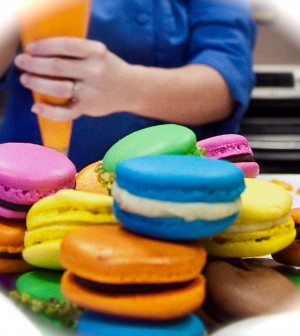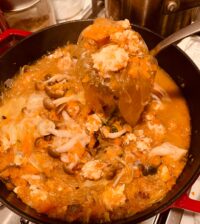- Belgium comes to Yamashita Park
- Residential Villa in Phuket Entices Remote Workers With Long-Stay Rates
- Rare pieces of French glass art at the Mirai Museum of Art
- Feast on fresh fish and seafood at the 2024 ‘Sakana’ Festival
- Would you like to ride in a Louis Vuitton gondola lift?
- Naked Snow Aquarium
- Festive lights at Yomiuriland will get you feeling the holiday vibes
Trick or Thrift

Fixing something cool for 30 or more trick-or-treaters and staying within budget can be a daunting task. Not if you keep it simple.
Perhaps one of the simplest recipes ever created that costs little to prepare and makes a good halloween treat is a macaron. What’s great about this wonder nibble is the myriad ways of giving it a personal touch. Although it is originally a French creation, macaron has been adopted in various cultures. The Japanese version uses plant-based ingredients that give it a “wagashi” or traditional flavour. However you prefer to make your macaron, start with the basic recipe below courtesy of Hisako Ogita.
You need:
2/3 cup ground almonds
1 teaspoon Vanilla extract
1 1/2 cups confectioner’s sugar
3 large eggs whites stored (eggs kept unrefrigerated
for at least 3 days)
5 tablespoons granulated sugar
Wilton food coloring
1. Preheat the oven to 280º and position two racks in the lower section of the oven. Line two rimmed baking sheets with parchment paper. If you have time, draw 1-inch circles on the back of each sheet, spacing the circles at least 1/2-inch apart.
2. If your almond meal is very coarse, grind it with the powdered sugar in a food processor until fine. Sift the almond meal-powdered sugar mixture twice through a mesh sieve.
3. Place egg whites in the bowl of a stand mixer (or use a hand mixer) and begin to beat on medium-high. When the eggs are frothy, gradually add granulated sugar one tablespoon at a time until fully incorporated. Continue to beat the egg white mixture until glossy and stiff peaks form when you lift the beaters. Gently stir in the vanilla extract. Be careful to not overbeat the meringue (e.g., the meringue takes on a clumpy texture). Now, add the powder food coloring. If you use liquid, you add it at the beginning.
4. Add half of the sifted almond mixture and gently fold it into the meringue using a flexible silicone spatula. Lift from the bottom, up around the sides, and toward the middle, being careful to not overagitate the meringue and lose too much air. Once the almond mixture is predominantly incorporated, add the second half and repeat the folding motion.
5. When the almond mixture is just incorporated, you will need to transform the batter into the appropriate texture. Using the flat of the spatula, “punch” down into the center of the batter, then scrape more batter from the sides to the center, and punch again. You will need to repeat this 10-15 times (or more, depending on your arm strength and the beginning texture of your batter) until the batter slowly and continuously drips back into the bowl when you scoop it up with the spatula. Think of the consistency of molten lava. For the best results, punch the batter a few times, check the consistency, then punch a few more times, etc. Do not make the batter too runny or the macarons won’t rise as they should, and you could end up with oil stains on the surface.
6. Pour batter into a pastry bag fitted with a 0.4-inch tip. In a pinch, you can also use a gallon size Ziploc bag: just snip a teeny bit from one of the bottom corners. Twist and clip the top of the bag to avoid overflow. On your prepared baking sheets, pipe out 1-inch rounds in the circles you drew (remember to draw the circles on the back side of your parchment to avoid ink or pencil stains on your macarons!).
7. Holding the baking sheet in both hands, rap each baking sheet firmly on the counter two or three times. This smooths out the tops and helps form the “pied” or frilly foot on the bottoms of the macarons. Allow the piped macarons to dry, uncovered, for at least 15 minutes. The macarons should form a very thin, smooth crust where, if you tap it lightly with your finger, the batter will not stick to your finger. If after 15 minutes, the batter is still sticky, let it dry longer. This may take up to an hour on humid days.
8. Place both baking sheets in the oven and bake for 15-18 minutes. After the first 2 minutes, open the oven to allow any excess humidity to escape. Halfway through, swap oven racks and rotate the sheets for even baking. The macarons are done when they are baked all the way through and the shells are just hard. Take care to not underbake (insides will still be mushy) or overbake (tops will begin to brown). Remove them from the oven, and cool on baking sheet placed on a wire rack.
9. When fully cooled, assemble the macarons with your choice of filling. The assembled macarons can be stored in an airtight container in the refrigerator for up to one week.
Makes about 4 dozen macaron halves (about 2 dozen complete macarons).
Classic Macaron Buttercream Filling
Ingredients
7 tablespoons unsalted butter, softened
2 egg yolks
1/4 cup granulated sugar
3 1/2 tablespoons milk
1 teaspoon vanilla extract
Directions
Just like the basic macaron recipe, the basic buttercream filling recipe can be customized with endless flavors and colors. But don’t stop at buttercream! Try jams and preserves (or even Nutella!) straight out of the jar or whip up a quick chocolate ganache for a decadent spin on the macaron.
1. Cut butter into pieces and mash with a spatula until the consistency resembles mayonnaise.
2. In a small bowl, whisk the egg yolks, then add the granulated sugar and whisk until the mixture lightens to an off-white and you can no longer see the granules of sugar. Add the milk, and whisk to combine.
3. Pour the egg mixture into a small saucepan and heat over low heat, whisking frequently to ensure that the mixture does not curdle or scorch. Cook until the mixture becomes thick and custardy, like pudding.
4. Pour the egg mixture back into its bowl and whisk constantly until it returns to room temperature. Whisk in the butter in three batches, add the vanilla, and stir until smooth and all ingredients are fully combined. Pipe or spread onto one macaron half and sandwich between the other.
Makes enough for 2 dozen macarons.


















